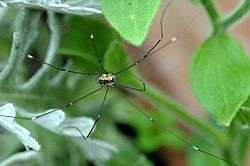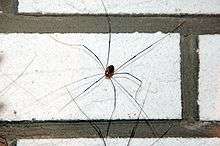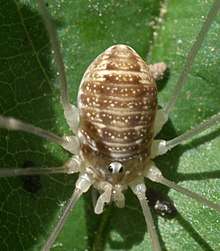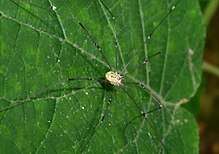Leiobunum
Leiobunum is a genus of the harvestman family Sclerosomatidae with more than a hundred described species. Contrary to popular belief, they are not spiders, although they share a resemblance. They are arachnids, in the order Opiliones, harvestmen. Species in Leiobunum tend to have relatively long legs compared with other harvestmen, and some species are gregarious.
| Leiobunum | |
|---|---|
 | |
| female L. rotundum | |
| Scientific classification | |
| Kingdom: | Animalia |
| Phylum: | Arthropoda |
| Subphylum: | Chelicerata |
| Class: | Arachnida |
| Order: | Opiliones |
| Family: | Sclerosomatidae |
| Genus: | Leiobunum C. L. Koch, 1839 |
| Type species | |
| Phalangium rotundum Latreille, 1798 | |
| Species | |
|
Leiobunum politum
| |
| Diversity | |
| c. 120 species | |
Body Form
The teguments are soft or subcoriaceous. The striae of the cephalothorax and of the three last abdominal segments are very distinct; those of the anterior segments are scarcely or not at all distinct. The anterior and lateral borders of the cephalothorax are smooth. The eye eminence is relatively small; smooth or, rarely, provided with small, slightly distinct, tubercles; widely separated from the cephalic border. Lateral pores small, oval, and marginal. Anal piece large, transverse-oval or semicircular, much wider than long, and much wider than the reflected borders of the eighth segment. Mandibles short, similar in the two sexes ; first joint furnished at the base below with an acute tooth. Palpi simple ; femur, patella, and tibia without any process and without projecting angles ; maxillary lobe provided at the base with two strong, conical teeth. Maxillary lobe of the second pair of feet very long, nearly straight from the base, not attenuated, directed mesad nearly horizontally, and united on the ventro-meson to the lobe from the opposite side without forming a sensible angle; the two together lightly arched on the cephalic border, and forming an even curve. Sternal piece large, slightly contracted between the fourth pair of coxae, gradually enlarging and obtusely truncate cephalad. The feet are very long and slender; tibia of the second pair with a few false articulations. Palpal claw denticulate.[1] Many Leiobunum species tend to form clusters of several, but some up to 1,000 and more individuals.
Invasive species in Europe



An as yet undescribed species of Leiobunum was first found in the Netherlands in October 2004, although reports date back to at least 2002. Since then it has been identified from Germany, Switzerland and Austria. It is distinct from all known central European species and was probably introduced. This species has a strong tendency to group together, most of the time protected from wind and direct sunlight, and stay in one place for weeks. They swarm out at night to hunt on their own. When disturbed, they move their bodies up and down in a fast rhythmic motion, with individuals moving away from the disturbance. The first juvenile stages seem to live on the ground below rocks and debris. The largest observed aggregation counted 770 individuals.[2]
Species
- Leiobunum annulipes Banks, 1909 (Costa Rica)
- Leiobunum albigenium Sorensen, 1911 (Syria)
- Leiobunum aldrichi (Weed, 1893)[3]
- Leiobunum alvarezi Goodnight & Goodnight, 1945 (Mexico)
- Leiobunum anatolicum Roewer, 1957
- Leiobunum annulatum Walker, 1930 (USA)
- Leiobunum apenninicum (Martens, 1969)[3]
- Leiobunum aurugineum Crosby & Bishop, 1924 (southeastern USA)
- Leiobunum bicolor (Wood, 1870) (eastern USA)
- Leiobunum bifrons Roewer, 1957
- Leiobunum bimaculatum Banks, 1893 (California)
- Leiobunum biseriatum Roewer, 1910 (Morocco, Portugal, Spain)
- Leiobunum biseriatum biseriatum Roewer, 1910
- Leiobunum biseriatum defectivum Rambla, 1959
- Leiobunum blackwalli Meade, 1861 (central Europe)
- Leiobunum bogerti Goodnight & Goodnight, 1942 (Mexico)
- Leiobunum bolivari Goodnight & Goodnight, 1945 (Mexico)
- Leiobunum bracchiolum C.R.McGhee, 1977
- Leiobunum bruchi Mello-Leitão, 1933
- Leiobunum brunnea Walker, 1930 (USA)
- Leiobunum calcar (Wood, 1870) (northeastern USA)
- Leiobunum caporiacci Roewer, 1957
- Leiobunum coccineum Simon, 1878 (Algeria)
- Leiobunum colimae Goodnight & Goodnight, 1945 (Mexico)
- Leiobunum consimile Banks, 1900 (Mexico)
- Leiobunum crassipalpe Banks, 1909 (Washington)
- Leiobunum cretatum Crosby & Bishop, 1924 (southeastern USA)
- Leiobunum cupreum Simon, 1878
- Leiobunum curvipalpi Roewer, 1910 (Japan)
- Leiobunum cypricum Roewer, 1957
- Leiobunum davisi (Goodnight & Goodnight, 1942)(Mexico)
- Leiobunum denticulatum Banks, 1900 (Mexico)
- Leiobunum depressum Davis, 1934 (USA)
- Leiobunum desertum Goodnight & Goodnight, 1944 (Mexico)
- Leiobunum dromedarium F.O.Pickard-Cambridge, 1904 (Mexico)
- Leiobunum ephippiatum Roewer, 1910 (Oregon)
- Leiobunum escondidum Chamberlin, 1925 (California)
- Leiobunum euserratipalpe Ingianni, McGhee & Shultz, 2011[3]
- Leiobunum exillipes (Wood, 1878) (California, Nevada)
- Leiobunum flavum Banks, 1894 (Louisiana, Mexico)
- Leiobunum flavum flavum Banks, 1894
- Leiobunum flavum leiopenis Davis, 1934 (USA)
- Leiobunum formosum (Wood, 1870) (northeastern USA)
- Leiobunum fuscum Roewer, 1910 (Guatemala)
- Leiobunum ghigii Caporiacco, 1929 (Italy)
- Leiobunum globosum Suzuki, 1953
- Leiobunum glabrum L.Koch, 1869 (Tirols)
- Leiobunum gordoni Goodnight & Goodnight, 1945 (Alabama)
- Leiobunum gracile Thorell, 1876[3]
- Leiobunum gruberi Karaman, 1996 (Macedonia)
- Leiobunum guerreoensis Goodnight & Goodnight, 1946 (Mexico)
- Leiobunum hedini Roewer, 1936 (China)
- Leiobunum heinrichi Roewer, 1957
- Leiobunum hiasai Suzuki, 1976
- Leiobunum hikocola Suzuki, 1966
- Leiobunum hiraiwai (Sato & Suzuki, 1939)
- Leiobunum hiraiwai hiraiwai (Sato & Suzuki, 1939)
- Leiobunum hiraiwai fuji Suzuki, 1976
- Leiobunum hiraiwai izuense Suzuki, 1976
- Leiobunum hiraiwai longum Suzuki, 1976
- Leiobunum hiraiwai shiranense Suzuki, 1976
- Leiobunum hoffmani Ingianni, McGhee and Shultz, 2011[3]
- Leiobunum holtae McGhee, 1977
- Leiobunum hongkongium Roewer, 1957
- Leiobunum hoogstraali Goodnight & Goodnight, 1942 (Mexico)
- Leiobunum knighti Goodnight & Goodnight, 1942 (Mexico)
- Leiobunum humile Koch, 1876
- † Leiobunum inclusum Roewer, 1939 (fossil: Baltic amber)
- Leiobunum insignitum Roewer, 1910 (Mexico)
- Leiobunum insulare Roewer, 1957
- Leiobunum ischionotatum (Dugès, 1884) (Mexico)
- Leiobunum ischionotatum ischionotatum (Dugès, 1884)
- Leiobunum ischionotatum luteovittatum Roewer, 1912 (Mexico)
- Leiobunum japanense (Müller, 1914) (Japan)
- Leiobunum japanense japanense (Müller, 1914)
- Leiobunum japanense japonicum (Suzuki, 1940)
- Leiobunum japanense uenoi Suzuki, 1964
- Leiobunum japonicum (Müller, 1914) (Japan)
- Leiobunum kohyai Suzuki, 1953
- Leiobunum limbatum L.Koch, 1861 (Alps)
- Leiobunum lindbergi Roewer, 1959
- Leiobunum longipes Weed, 1890 (northern USA)
- Leiobunum longipes longipes Weed, 1890
- Leiobunum longipes aldrichi Weed, 1893
- Leiobunum lusitanicum Roewer, 1923 (Portugal)
- Leiobunum maculosus (Wood, 1868)[3]
- Leiobunum manubriatum (Karsch, 1881) (Japan)
- Leiobunum marmoratum F.O.Pickard-Cambridge, 1904 (Mexico)
- Leiobunum maximum Roewer, 1910 (China, Japan)
- Leiobunum maximum maximum Roewer, 1910
- Leiobunum maximum distinctum Suzuki, 1973
- Leiobunum maximum formosum Suzuki, 1976
- Leiobunum maximum yushan Suzuki, 1976
- Leiobunum mesopunctatum Goodnight & Goodnight, 1942 (Mexico)
- Leiobunum metallicum Roewer, 1932 (Mexico)
- Leiobunum mexicanum Banks, 1898 (Mexico)
- Leiobunum mirum Roewer, 1957
- Leiobunum montanum Suzuki, 1953
- Leiobunum montanum montanum Suzuki, 1953
- Leiobunum montanum sobosanum Suzuki, 1976
- Leiobunum nigrigenum Goodnight & Goodnight, 1945 (Mexico)
- Leiobunum nigripes Weed, 1887
- Leiobunum nigripalpe (Simon, 1879) (France)
- Leiobunum nigropalpi (Wood, 1870) (northeastern USA)
- Leiobunum nycticorpum Goodnight & Goodnight, 1942 (Mexico)
- Leiobunum oharai N. Tsurusaki, 1991 (Taiwan)
- Leiobunum oregonense C.J. Goodnight and M.L. Goodnight, 1943[3]
- Leiobunum paessleri Roewer, 1910
- Leiobunum patzquarum Goodnight & Goodnight, 1942 (Mexico)
- Leiobunum peninsulare Davis, 1934 (USA)
- Leiobunum politum Weed, 1890 (eastern USA)
- Leiobunum politum politum Weed, 1890
- Leiobunum politum magnum Weed, 1893 (Mississippi)
- Leiobunum potanini (Schenkel, 1963)
- Leiobunum potosum Goodnight & Goodnight, 1942 (Mexico)
- Leiobunum relictum Davis, 1934 (USA)
- Leiobunum religiosum (Simon, 1879) (France)
- Leiobunum roseum C.L.Koch, in Hahn & C.L.Koch 1848 (Tirols)
- Leiobunum rotundum (Latreille, 1798) (Europe, North Africa, Canary Islands)
- Leiobunum royali Goodnight & Goodnight, 1946 (Mexico)
- Leiobunum rubrum Suzuki, 1966
- Leiobunum rumelicum Silhavý, 1965
- Leiobunum rupestre (Herbst, 1799) (central Europe)
- Leiobunum sadoense N. Tsurusaki, 1982 (Japan)
- † Leiobunum sarapum Menge, 1854 (fossil)
- Leiobunum seriatum Simon, 1878 (Asia Minor)
- Leiobunum seriepunctatum Doleschall, 1852
- Leiobunum serratipalpe Roewer, 1910[4]
- Leiobunum silum Shultz, 2018[3]
- Leiobunum simplum Suzuki, 1976
- Leiobunum socialissium C.L.Koch, 1873 (Morocco)
- Leiobunum soproniense Szalay, 1951
- Leiobunum speciosum Banks, 1900 (Alabama)
- Leiobunum subalpinum Komposch, 1998[3]
- Leiobunum supracheliceralis Roewer, 1957
- Leiobunum tamanum Suzuki, 1958
- Leiobunum tascum Goodnight & Goodnight, 1945 (Mexico)
- Leiobunum tisciae Avram, 1968[3]
- Leiobunum tohokuense Suzuki, 1976
- Leiobunum townsendi Weed, 1893 (Texas, Arizona)
- Leiobunum trimaculatum Goodnight & Goodnight, 1943 (Florida)
- Leiobunum tsushimense Suzuki, 1976
- Leiobunum uxorium (Crosby & Bishop, 1924)[3] (southeastern USA)
- Leiobunum ventricosum (Wood, 1870) (northeastern USA, Nebraska)
- Leiobunum ventricosum ventricosum (Wood, 1870)
- Leiobunum ventricosum hiemale (Weed, 1890) (southeastern USA)
- Leiobunum ventricosum floridanum Davis, 1934 (Florida)
- Leiobunum veracruzensis Goodnight & Goodnight, 1947
- Leiobunum viridorsum Goodnight & Goodnight, 1942 (Mexico)
- Leiobunum verrucosum (Wood, 1870) (New York)
- Leiobunum vittatum (Say, 1821) (central USA)
- Leiobunum vittatum vittatum (Say, 1821)
- Leiobunum vittatum dorsatum Say, 1821 (northern USA)
- Leiobunum vittatum minor Weed, 1892 (South Dakota)
- Leiobunum wegneri Silhavý, 1976
- Leiobunum zimmermani Roewer, 1952
Notes
- Weed, Clarence M., 1889: A descriptive catalogue of the Phalangiinae of Illinois. In: Bulletin of the Illinois State Laboratory of Natural History, Urbana, Ill., 3(5):81-82:
- Wijnhoven et al. 2007
- "Leiobunum". GBIF. Retrieved 2018-05-04.
- "Leiobunum Genus Information". BugGuide.net. Retrieved 2018-05-04.
- Joel Hallan's Biology Catalog: Sclerosomatidae
- Wijnhoven, Hay; Schönhofer, Axel L. & Martens, Jochen (2007): An unidentified harvestman Leiobunum sp. alarmingly invading Europe (Arachnida: Opiliones). Arachnol. Mitt. 34: 27-38. PDF
- Kury, A.B. (2014). "Classification of Opiliones". National Museum of Brazil. Retrieved 2018-05-04.